Walking the Restored Stone Paths of Tsagarada in...
Two years after the devastation caused...
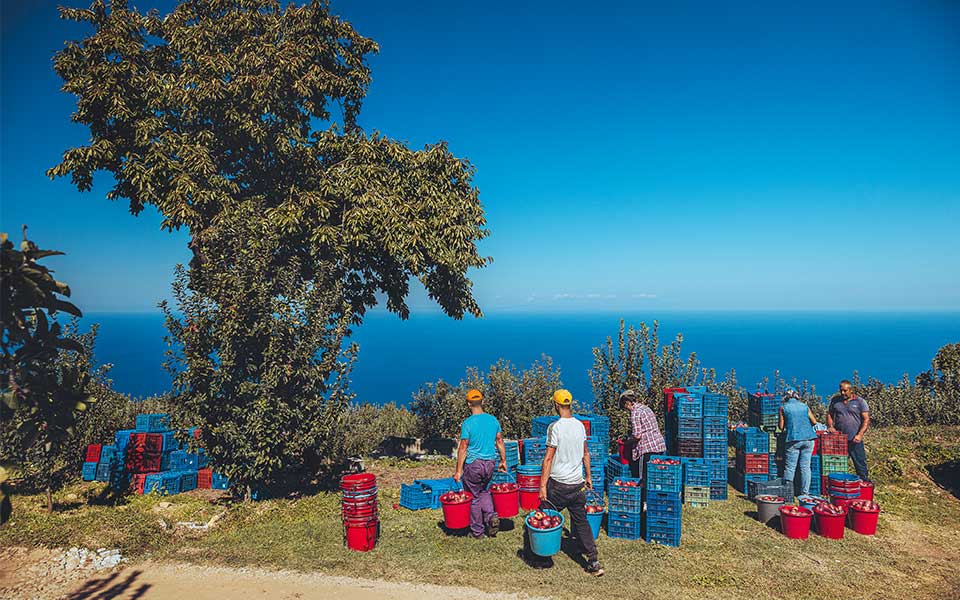
In the field of the president of Zagorin, Yannis Kravvaris, after Pouri. Most producers have fields in various parts of the region.
© Nick Boutsikos/Nidibou Photography
Zagora, the most populous village of Pilio, is famous for its fruits and especially for its apples, producing more than 9,000 tons annually, from one million trees, planted on 1,200 hectares of land. Apples are harvested in autumn and if you happen to be in the area, you will see all the inhabitants of Zagora working in the orchards.
Apple trees are everywhere and they are full of fruits. Among them, there are huge chestnut trees, kiwi crops, pear trees but also blackberry bushes, fig trees, peaches and cherry trees. All this, thanks to the microclimate of the area and to the slope of the mountain, which traps the clouds coming from the Aegean Sea and keeps them above it, pouring tons of rain annually, maintaining the humidity, making the soil fertile and the earth sprouting impressively. Here, green spreads as far as your eye can see.
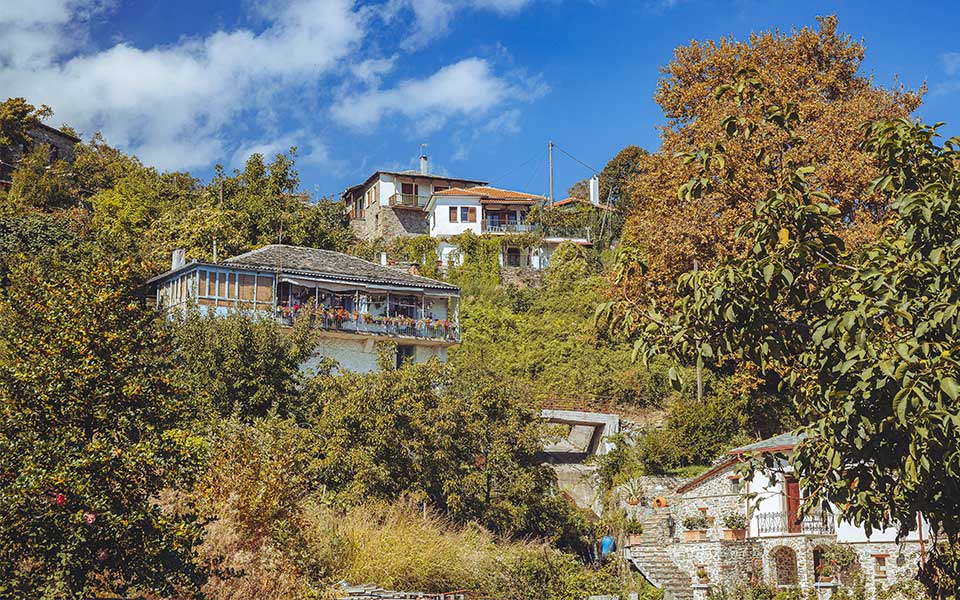
© Nick Boutsikos/Nidibou Photography
The dense forests of Pilio, which are impervious to the sunlight, gave it the nickname “magic mountain.” “The combination of the mountain and the sea, the low winter temperatures, the hot summer days and cool nights and the acidic soil due to the rich waters of the area contribute to the uniqueness of Zagora, which give its apples their distinctive taste and deep red color,” says the president of Zagorin, the Agricultural Cooperative of Zagora, Yannis Kravvaris, who we met in his field, while he was picking apples, with a view of the sea.
First established in 1916, the cooperative currently has 800 members. In its 106 years of operation, it has remained healthy and active, exporting its products and expanding its production and facilities, and, in 1996, having its apples recognized as Protected Designation of Origin products. In fact, it was registered in the National Intangible Cultural Heritage Index in 2018 for its manual cultivation methods and its great tradition in the guild, which began in the 17th century with the famous Zagorian skoutia (coarse woollen cloths).
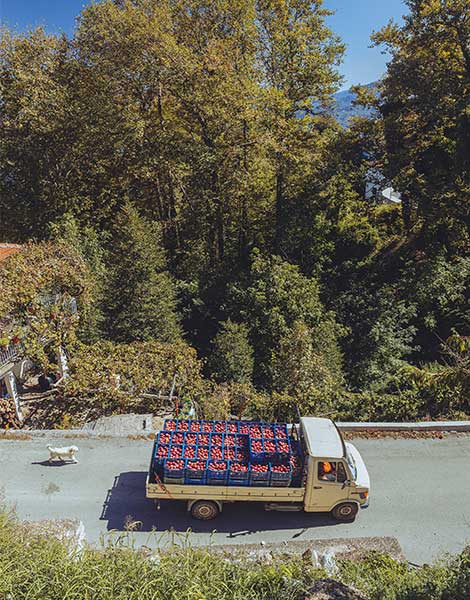
© Nick Boutsikos/Nidibou Photography
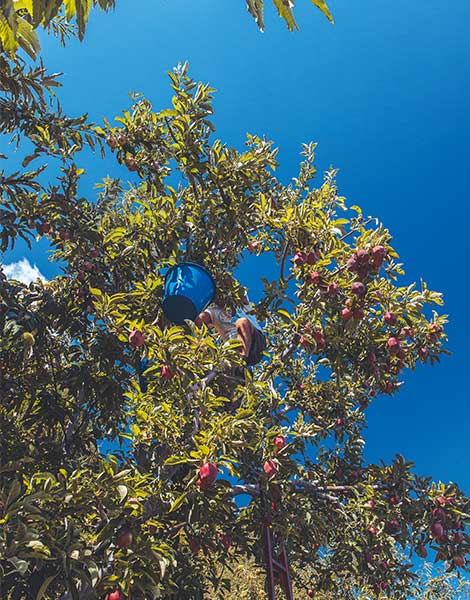
© Nick Boutsikos/Nidibou Photography
The “Starking delicious” variety was first imported from California in the 1930s. Until then, what was mainly cultivated here were the manias and firikis apple varieties, hazelnuts and potatoes. Using the grafting technique, this variety has been combined with the old ones to give the crimson apple of Zagora that we all know, which is cultivated in three zones from 200m to 800m altitude. Since 1922, the people of Zagora have been giving 100% of their production to the cooperative, be it the various apple varieties or pears, chestnuts, kiwis and cherries. You will see them in the afternoons halfway between Zagora and Horefto, where the cooperative is located, queuing in their trucks to unload their products.
Through an easy-to-use digital system, the apples will make their way to sorting, washing and packaging. The new sorting machine is justifiably the pride of the cooperative: we watched it sort the apples per size and color and even scan them for any hidden, internal defects. “Only first-class apples are sold on the Greek market, while in fact they have no difference in taste from the rest,” says Ioulia Papoulia, one of the agronomists of the cooperative who, together with her colleagues, intervenes in all stages, from spraying to harvesting, and the final quality control. The rest of the apples are exported at a lower price or are given for juice production.
The cooperative is not into processing the fruits yet. It has only created an award-winning apple syrup, in cooperation with Women’s Agrotourism Cooperative of Zagora. Nor are there any other Zagorians involved in processing. It is as if they all rest in agricultural cultivation, even though it is not enough for a living. “When we had drachmas, we lived only on apples, now everyone has to do other jobs at the same time,” says Mr. Vassilis Kalavros, who has now handed over the baton to his son, Kostas. He returned permanently to Zagora in 2011 for a better quality of life, converted the four-hectare farm to organic and takes care of apple and olive trees as if they were his children. His mother and some friends are with him in the orchard and later, his wife will also pass by. This is how most of the Zagorians work, as a family. You meet them in the most unexpected places, you hear their voices through the woods as if they were elves. Sometimes they sing, sometimes they joke, and sometimes they set up small celebrations.
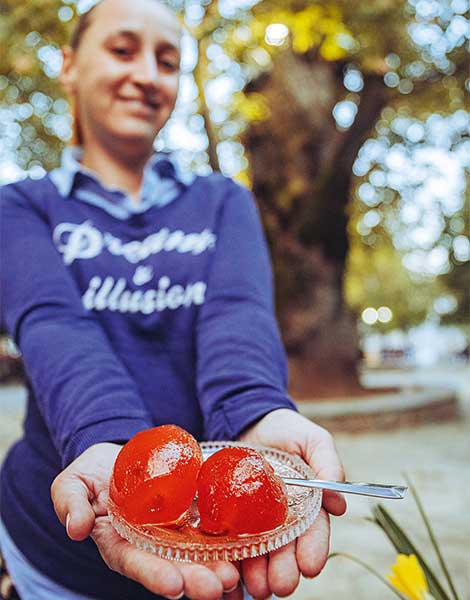
© Nick Boutsikos/Nidibou Photography
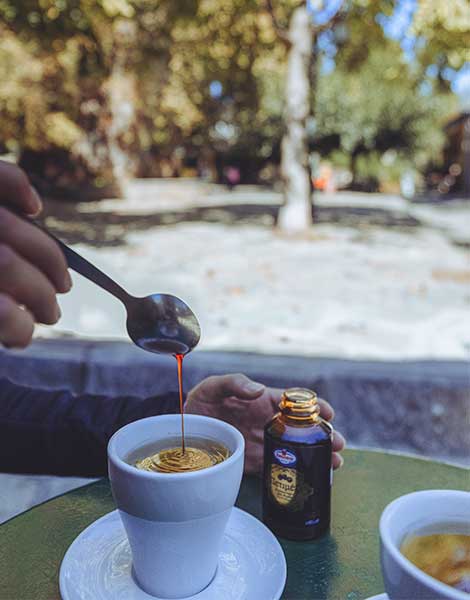
© Nick Boutsikos/Nidibou Photography
At the same time, Zagora, the largest village of Pelion with 2,000 inhabitants, looks deserted. Even the priests are in the fields, the churches remain locked and many shops are closed for days. In Tzanos’ café, in the square of Aghios Georgios, a few retirees drink their coffee with a view of the impressive old plane trees. They are also talking about apples; about the new variety, called Palmetta, which came from Italy and is dividing the producers. Mr. Yiannis, the owner of the café, serves us infusions from Pilio with apple syrup and tells us about the 200-year-old café. He shows us old photos from political gatherings that took place in the square, tells us about Eleftherios Venizelos, who was adored by the café’s frequenters and who is now “embedded” here, painted even on the coffee saucers and explains to us how Zagora has always produced and exported products.
It is a historical village, which comprises four districts that are more like four different villages, founded around the 12th century. It flourished in the 17th and 18th centuries with the production and trade of silk and skoutia (a special kind of woollen garment), thanks to which it enjoyed special privileges during the Ottoman rule and a lighter regime, which in turn attracted people from different regions of Greece. Such was its heyday, that the whole area was named after it – Zagora villages, Zagora mountain, etc., “Zagora” meaning “the place behind the mountain.”
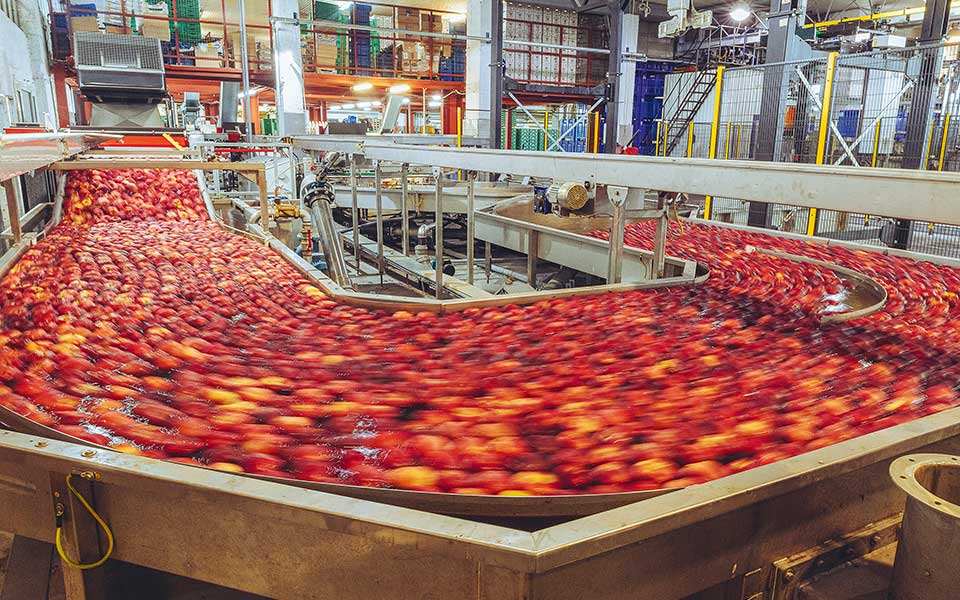
© Nick Boutsikos/Nidibou Photography
Trade with the central and eastern Mediterranean was carried out by the famous Zagorian ships from the port of Horefto, which today is the most touristic destination of northern Pilio – although the term “touristic” is not the right one to describe this area. This is how the Zagorian merchants excelled, became rich and benefited their village. They built beautiful churches and mansions, narrow cobblestone streets, and the famous Hellenic Museum, the first important school of Pilio, where Rigas Feraios also studied. Today, it is closed to the public, but it is expected to reopen soon.
The Library of Zagora, founded in 1762, can be visited on weekdays and although it houses priceless manuscripts, only a few of them are on display. It is located in the third district, Aghios Georgios, which is the most beautiful out of the four districts of Zagora. The first one, Aghia Paraskevi or Perachora, is the most distant and most unorganized, the second is Aghia Kyriaki with its magnificent square on the main road and the fourth, Sotira, seems to be the first to be founded. All are named after their respective churches, which were built in the 18th or 19th centuries. In Aghios Georgios however, you will enjoy the most beautiful walks.
Narrow cobblestone streets, traditional Pilio mansions with sea views, typical Pilio slate roofs, which is mandatory in new constructions (but not subsidized). At the square you will find the Women’s Agrotourism Cooperative of Zagora, where women make fruit preserves and jams and run Drakopoulos Guesthouse (currently being renovated), which is housed in a beautiful mansion. Here you will also find the modern Ylien café, tasteful gifts at Gi Anatolis and jewelry at Syndetiras and you will be photographed inside the trunk of the spectacular central plane tree.
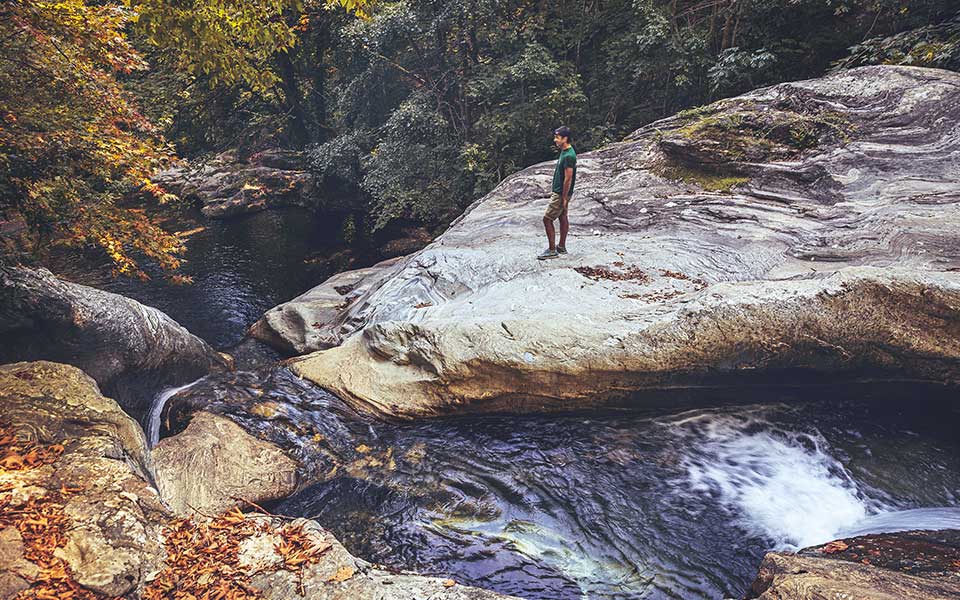
© Nick Boutsikos/Nidibou Photography
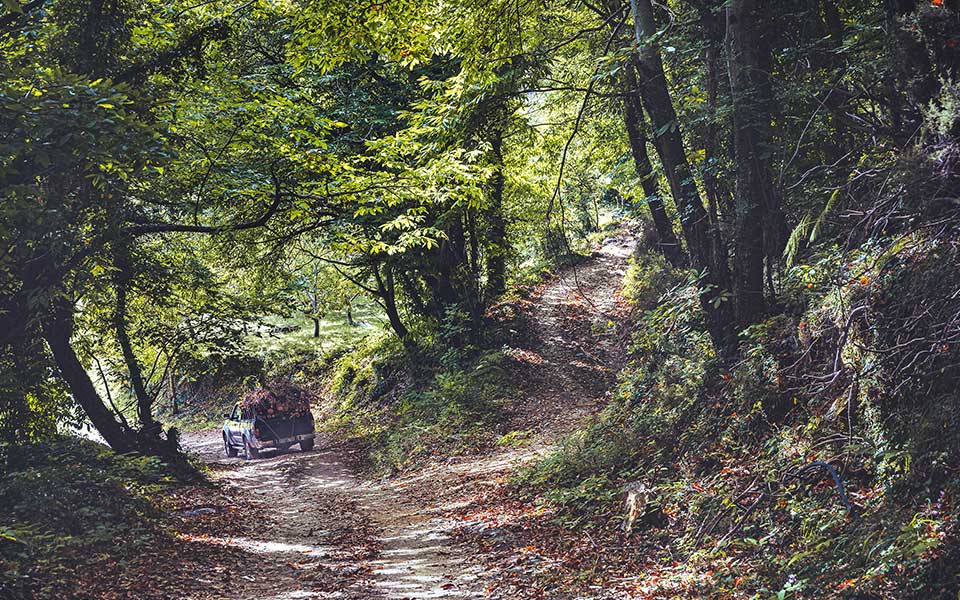
© Nick Boutsikos/Nidibou Photography
Two more neighboring villages, Makryrrahi and Pouri, have also based their economy on apples. Being members of the cooperative, these villages match the pace of Zagora in autumn. In the past, in Makryrrahi they also used to cultivate flowers: gardenias, camellias, hydrangeas and other species were cultivated here in greenhouses. This business has died down, but you will still find some greenhouses if you want to shop around. Makryrrahi is quite a long village, without particular architectural interest but with a well-placed square that features the typical plane tree, a café and a taverna. The most remarkable sight in Makryrrahi, however, are its natural pools, located between this village and Zagora (there is an improvised sign at the big intersection, between the two villages). After twenty minutes of walking next to apple and chestnut trees, on what is essentially a rural road, you will reach a green landscape with small waterfalls, natural ponds, flowering cyclamen and fallen chestnuts.
Pouri is located north of Zagora. On the way there, you will find a fork towards the Monastery of Panagia Rasova. The road is a passable dirt road and in 2.5km it takes you to an amazing, very quiet location, full of chestnut trees, with benches and an impressive cypress tree, from which the bell hangs. The church, built in the 13th century, is the Catholicon of the old monastery, which is no longer extant. Its two domes, protruding under the Pilio slate roof, look like camel humps!
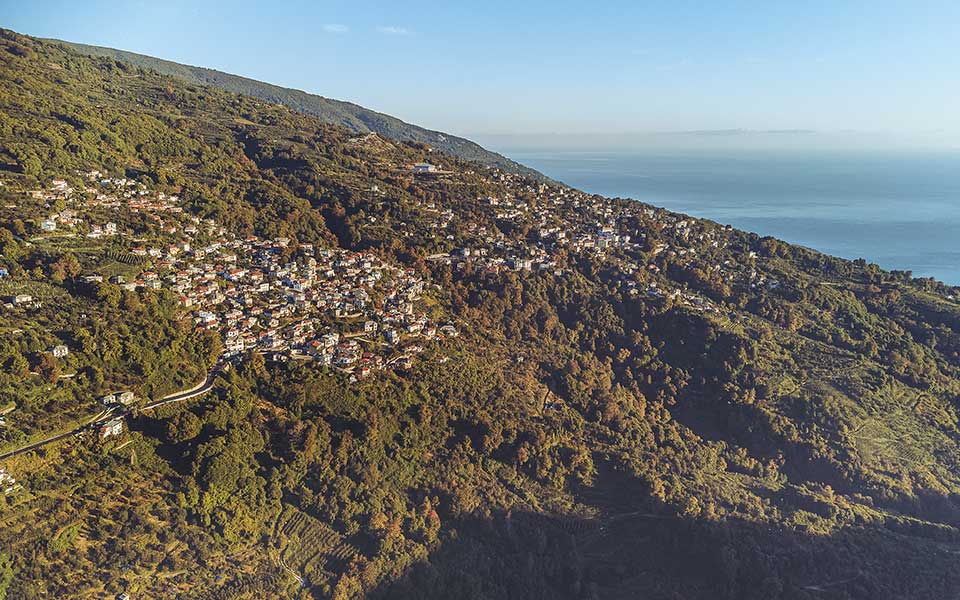
© Nick Boutsikos/Nidibou Photography
Pouri is a beautiful village, that stretches amphitheatrically, high on the hillside, so that all the houses have an unobstructed view of the sea. This area has rich vegetation, running waters and one of the largest waterfalls of Pilio, which is difficult to approach. Pouri is the most remote village of Pilio, since the villages of Veneto and Keramidi that are even further north (a dirt road leads to them from Ovrios), are built on the slopes of Mount Mavrovouni.
Follow the central cobblestone street, past the well-kept houses and you’ll reach its tiered square, which is built on three levels – a true balcony on the Aegean Sea. Here, you will also find the imposing church of Aghios Dimitrios, dating back to 1743 and the centuries-old plane tree, which offers its shade to Polydroso Taverna. “If it wasn’t for the plane tree, we wouldn’t be here,” says Anna, who set up her life in Pouri together with her partner Dimitris, in 2015, based on the principles of permaculture, without even knowing it. In their house they use solar panels to cover their energy needs, and their table, just like the tables of Polydrosο Taverna, is filled with delicacies prepared with ingredients collected from nature or grown by them.
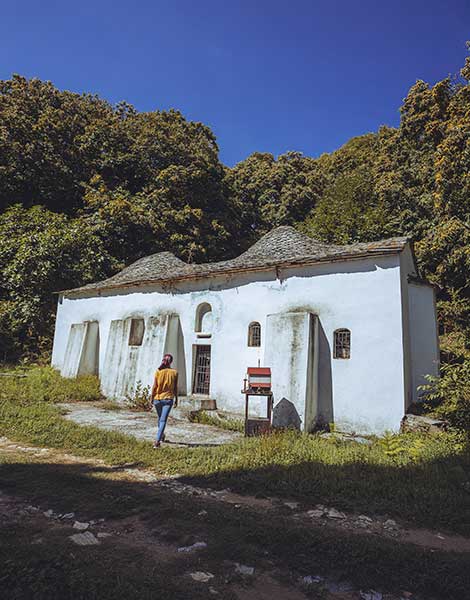
© Nick Boutsikos/Nidibou Photography
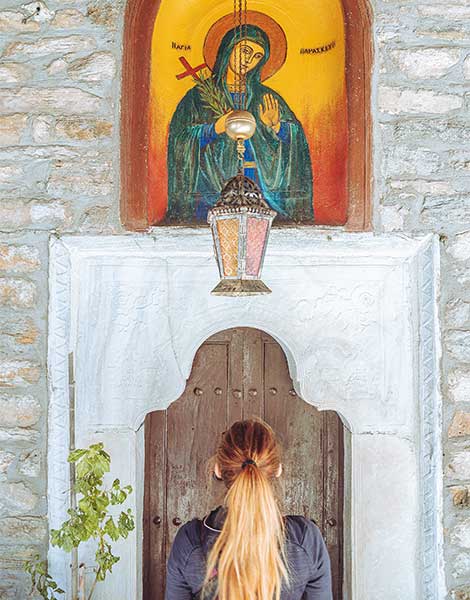
© Nick Boutsikos/Nidibou Photography
Palia Mitzela was a large area in northern Pilio. The main settlement had, as it is said, 19 churches and around 800 inhabitants, most of whom were sailors or loggers. Certainly, however, based on the legends and folk songs that have survived, they had a reputation as rebels (“Blood pours like a fountain, dead bodies fall one after the other and the Mitzeliots shoot countless shots/and the sky darkens and becomes hazy, absolute darkness”). This is precisely why their village was first destroyed by the Franks in the 13th century, as they did not recognize the papal authority, and then by the Turks in 1827, because the inhabitants participated with their ships in the liberation struggle. In fact, the women seem to have set up a second dance of Zalongo here, in order not to fall into the hands of the enemy. Today, this entire area is surrendered unconditionally to vegetation however, it is one of the most charming locations of Pilio.
Off the tourist roads, with dense forests, towering ferns, roots hanging from everywhere, moss that covers every sign of human presence, the area is crossed by the national trail O2, which, however, is not maintained. To get here, you must follow the route from Pouri to Ovrios Beach. The concrete road that starts before Pouri is easier, with a few difficult sections. If you have a 4×4 vehicle though, it’s worth just continuing on the road after Pοuri (about 7km), which crosses landscapes of forests, apple groves and offers a wonderful sea view. Before the beach of Ovrios, where the stream of Lagonika flows, you will see a sign on the left, where you must leave the car. The unkempt but clear path will soon lead you to the single-arched bridge of Diakoumis, said to have been built in the 19th century by Zoupaniot masters. Going up the opposite side, on the steep slope, sections of cobblestones, piles of stones and scattered remains of houses’ foundations will begin to appear in your path. The truth is that there is not much to see here, but the location is more than charming.
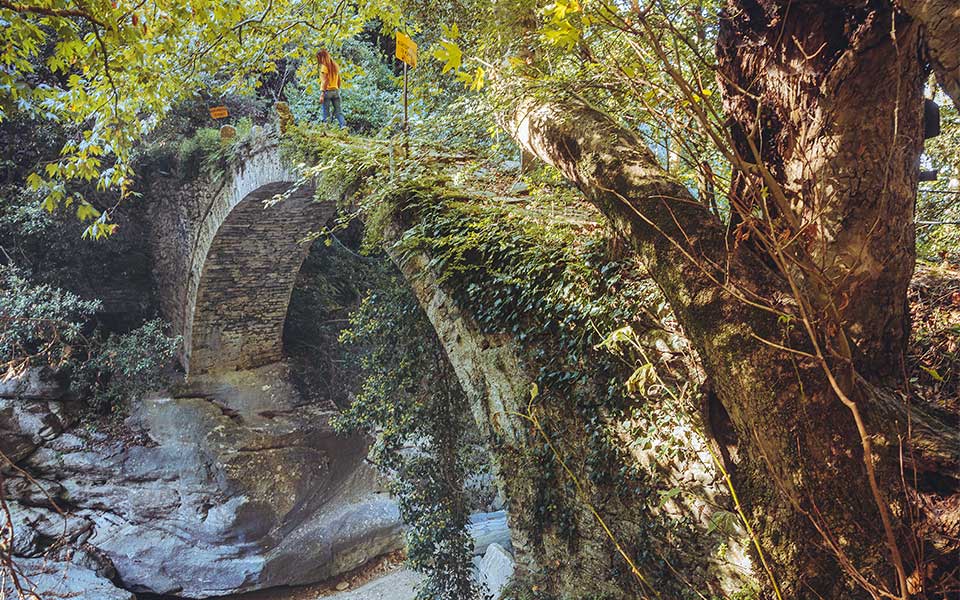
© Nick Boutsikos/Nidibou Photography
Dense mixed forests, plane trees, chestnut trees and apple orchards. Mountain, streams and sea. The hiking route that starts from Pouri and leads to Horefto, two enjoyable hours later, seems to include everything that makes Pilio so unique, like a microcosm of it. It starts from high up, from the parking lot of Pouri, crosses part of the village through a narrow cobblestone street and then enters the forest.
Enjoying the landscape of mushrooms and fallen leaves, follow the signs to Horefto and the red markings and you will find yourself on a dirt road to Elitsa Beach, next to which there is a ravine with a plane tree forest. You can continue from the rocky coast or from the road to the next beach, Analipsi (meaning Ascension), where you will find the homonymous church and Plymari Taverna, which is open only in the summer.
The old path, at the end of the beach, has been destroyed and you have to negotiate steep rocks (it is not particularly challenging, but you need to be careful). This way you will reach Tourkos Beach, also known as Tourkopigi, an incredible sandy beach that is accessible only to hikers and yachts. Here begins the nicest part of the route, a 20-30 minutes’ walk through vegetation and right over the sea (this part could slightly discomfort people suffering from acrophobia) to the long beach of Parisaena. Horefto is only 5 to 10 minutes from here.
* There are also two paths that connect Zagora with Horefto, which were used by the inhabitants in the old days to get down to the port. However, they have not been maintained and are blocked by vegetation. This unfortunately is also the case for many other hiking trails in the area.
GETTING THERE
Zagora is 370km from Athens and 250km from Thessaloniki. The cost for tolls and fuel is estimated at 70 and 40 euros respectively, for a one-way trip.
ACCOMMODATION
Stamou Guesthouse (Tel. (+30) 24260.238.80, at 65 euros, breakfast included). This is a mansion dating back to 1863, which belonged to the family of the national benefactor Alexandros Pantos. It has nine elegant rooms, decorated in a romantic, retro style (some of them have a fireplace and a view of the well-tended garden) and a beautiful communal lounge-café where breakfast is served, which deserves a special mention: breakfast is customized and changes daily; it includes local eggs (eggs in the oven with feta cheese served in an earthen pot, omelette with goat cheese, strapatsada (fresh tomato and egg scramble) or fried eggs), delicious local tiganokouloura (fried dough with feta cheese and spearmint) or pepper pie, apple pie, milk pie, home-made marmelades etc.
See also Zagora Ηotel (Tel. (+30) 24260.220.62, at 65 euros, breakfast included) with a pool and sea view and Theareston Guesthouse (Tel. (+30) 24260.224.22, at 70 euros, breakfast included) with sea view, fireplace, swimming pool, sauna and hot tub.
FOOD
Maidani Taverna (Τel. (+30) 24260.226.26) is the kingdom of Ms. Niki, an excellent cook, who has been serving homemade delicacies in Zagora for 26 years. Veal in lemon sauce, goat in tomato sauce and boar cooked with apples, chestnuts and quinces simmer in her casseroles on the stove, always based on seasonality. She also prepares local mushrooms and zucchinis with feta cheese in the pan and goat en papillote in the oven. Her salads are full of samphire, which is abundant in the (coastal) area, however the surprise dish is eggs with greens, a traditional recipe from Pilio, easy and cheap, which is definitely worth trying since it is prepared by such a competent hostess.
In the beautiful square of Pouri village, overlooking the sea, at Polydroso Taverna (Tel. (+30) 6938.882.207, in winter it is open only on weekends), a beautiful place decorated with doilies and laces, you will meet another excellent cook, Anna, who is formidable in the kitchen but also in singing and dancing. Here, you will try zucchini pie, boar stew with chestnuts, goat in tomato sauce, cabbage leaves stuffed with minced goat meat and rice. Also boubari (intestine stuffed with rice, chopped liver, herbs and spices in the oven), tsitsiravla (wild greens), mushrooms and wild greens, all collected by the owners of the taverna, but also salted cod with wild greens.
Another place with excellent cuisine is Patis Taverna (Tel. (+30) 24260.222.02), in the district of Aghia Kyriaki, which also specializes in mushrooms. Here, we tried exquisite white beans as well as boar and goat ribs. Psilou Taverna (Tel. (+30) 24260.236.33), in the district of Aghios Georgios, is a nice place specializing in meat, grilled perfectly. In the same district, you will also find Ylien café (Tel. (+30) 24260.235.77), where you can have coffee, apple pie, various snacks or even breakfast.
Two years after the devastation caused...
Whether you’re in northern, central or...
The charming port city of Volos...
A brave history and uniquely beautiful...